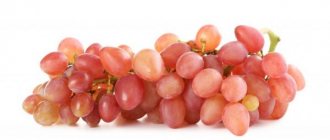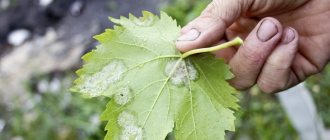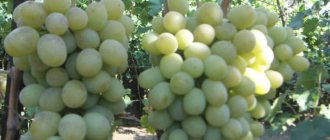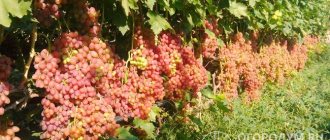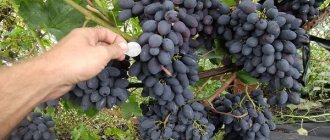Description of the Century grapes
The Century grape was bred in 1980 in California by crossing the Emperor and Pirovano-75 varieties.
The Century grape is an early ripening variety; the vine produces its first harvest 3 years after planting. The plant forms a powerful bush with dark olive, five-legged, large leaves. In the year of ripening, the clusters appear on the dark brown vine 130 days after the leaves emerge.
To obtain a bountiful harvest, Century grapes do not need pollinators, since the flowers are bisexual, with excellent self-pollination. After pollination, large clusters weighing up to 1200 g appear on the vine. They are cone-shaped and have an average density, thanks to which the crop is well transported over long distances.
A bunch of grapes is formed by round-ovoid, emerald berries weighing up to 8 g. Dense, crispy pulp is surrounded by a thin peel. The berry has a delicate nutmeg aroma and a sweet, not cloying taste, despite the fact that the sugar content is 15%. Century grapes are seedless varieties, so they are universal in use. It is consumed fresh and prepared into compotes. When grown on an industrial scale, high-class raisins are prepared from Stoletie grapes.
The harvest can be enjoyed immediately after ripening or left on the vine for a while. The dense shell does not crack, and the berry does not crumble after full ripening and can last until the first frost, acquiring an amber color.
Important! After flowering, the Stoletie grape stops growing and does not form stepsons, due to which care for the variety is minimal.
Despite the fact that Century is a southern variety, the grapes can withstand frosts down to -23 °C without shelter.
Features of crop formation
Grapes of this variety have repeatedly won prizes for their appearance. However, it's all about technology here.
The size of the bunches and berries directly depends on the thinning of the vine.
This variety is very plastic, and with the right processing and shaping you can easily achieve the desired result.
Thinning is the basis of large fruit production . By carrying out this operation and not being greedy, winegrowers manage to get a bunch weighing up to 2000 g, and berries up to 16 g. It is these bunches that have won titles and prizes.
Thinning is carried out at different stages. Both part of the berries and part of the young bunch are removed after the flowering period, but the inflorescences are not completely removed at all.
Trimming
Feedback from winegrowers regarding pruning was divided.
Some argue that the harvest is formed mainly on the lower parts of the shoots, while others say that long pruning is needed, since the fruitfulness at the base is not high.
Therefore, after planting a bush, you need to figure out for yourself exactly how the variety will behave in your conditions .
Pros and cons of sultana grapes Century
Century grapes, like other varieties, have their advantages and disadvantages. The advantages for gardeners include:
- stable and high productivity;
- ease of care;
- immunity to many diseases;
- cold resistance;
- not prone to peas;
- does not require pollinating varieties;
- high survival rate of cuttings;
- good taste and marketable appearance.
Despite the large number of advantages, winegrowers also highlight the disadvantages of Century grapes:
- forms a powerful bush, so it needs to be given the proper space for growing;
- short shelf life of fresh harvest;
- To obtain large berries, it is necessary to carry out timely thinning.
Circumcision procedure and preventive measures
It is better for the variety to be pruned long, with 6 - 8 buds. Because the eyes located at the base of the branches do not produce very well. The highest yield is obtained if the plant has 35 - 40 buds. And also 24 escapes maximum. After the bushes have flowered, 2-3 branches from the clusters are cut off. And before the fruits are filled, they are thinned out.
When the grapes fade, they must be sprayed with the store-bought product “Ridomil-gold” for prevention. 21 days before the ripening period, the drug “Topaz” is used.
Optimal growing conditions
Growth and development, yield and quality of berries depend on the correct soil and location. Despite the fact that Century grapes are cold-resistant, they need to be planted in a well-lit, southern location. With a lack of sunlight:
- internodes lengthen;
- the leaf blade turns a light emerald color, grows poorly and falls off quickly;
- Fruiting will be poor, and the quality of the berries will deteriorate.
Attention! Winegrowers do not recommend building a vineyard under the canopy of trees, near walls or between the bays of houses.
The Century grape is not picky about soil quality. But the best fruiting will be on light soil containing sand, pebbles and crushed stone. Such soil allows air to pass through well, reduces evaporation, warms up quickly and is easier to process.
If the site has clay soil, when digging, it is necessary to add a large amount of organic and mineral fertilizers, sand and crushed stone. Wetland with shallow groundwater is unsuitable for growing Stoletie grapes.
Reviews from winegrowers
The “Century” grape variety has earned good reviews from Russian and foreign winegrowers due to the fact that it does not require standardization of inflorescences, has a bisexual type of flowering and high pollination rates. However, it should be noted that the variety requires thinning of the berries, and it is advisable to remove part of the still unripe grape bunch immediately after ringing and flowering.
“Kishmish Century” is not susceptible to peas, so it should not be used for processing “Gibberellin”. According to the observations of gardeners, the variety has a fairly low fruitfulness of the buds at the base and therefore requires long pruning, which will increase the yield.
Planting and caring for Century grapes
To obtain a good harvest, it is important to choose the right seedling, prepare the planting hole and further care. High-quality planting material must meet certain requirements:
- It is better to purchase Century grape seedlings from trusted suppliers or nurseries immediately before planting;
- give preference to a grafted specimen, as it produces a richer harvest and is immune to many diseases;
- a healthy plant must have a strong, well-developed root system; the more roots, the better the survival rate;
- purchase planting material with closed roots, since drying out is the main enemy for grapes;
- a high-quality specimen always has a strong trunk without mechanical damage or signs of disease;
- With gentle pressure on the kidneys, they should not peel off or fall off.
Experienced winegrowers do not recommend purchasing Century grape seedlings with foliage, as it takes a lot of energy from the plant.
Advice! A healthy seedling can be identified by the cut of the root; it should be moist, white, similar to raw potatoes.
Selection and preparation of a landing site
The most important condition for good growth and development is the right location and timely preparation of the site. It is better to make the planting hole in a lighted place, on the south or southwest side. The site for growing Century grapes should be well protected from gusty winds by buildings or hedges.
Since the Century grapes grow a powerful root system with age, the grapes are planted at a distance of 4 m from trees and shrubs.
The soil for planting begins to be prepared a month before planting. To do this, the area is cleared of weeds, dug up and per square meter. m add a bucket of manure and 150 g of wood ash. Then the ground is leveled and high beds are made, 1 m wide and up to half a meter high.
To protect from the wind, sides are made of brick in the form of a trapezoid. After preparing the beds, install a trellis along which the vine will subsequently climb.
14 days before planting, dig holes measuring 50x50x50 cm. Place a 15 cm layer of drainage, 2 buckets of humus, half a kilogram of superphosphate, 150 g of potassium sulfate on the bottom. The top layer should consist of fertile soil.
Advice! Since the Century grape forms a powerful bush, the distance between the holes should be at least 2.5 m.
Landing rules
Century grapes can be planted in spring and autumn, it all depends on climatic conditions. Before planting, for better survival, it is necessary to prepare the seedling:
- First, it is placed in cold water with the addition of a growth stimulator for a day.
- The soaked planting material is shortened, leaving 3-4 eyes.
- The upper roots are removed, the lower ones are cut by 2 cm.
- To protect against diseases, the plant is sprayed with fungicides.
The fertilized soil is removed from the prepared hole down to the drainage layer and mixed thoroughly. The nutrient mixture is placed in a mound in the hole and the seedling with the root system straightened is carefully placed on it. The seedling is covered with earth, compacting each layer so that an air cushion does not form. The planted grapes are tied to a trellis, watered generously, and the ground is mulched.
Watering and fertilizing
For full growth and development, Century grapes require abundant watering. It is carried out several times per season:
- in spring - during the period of leaf blossoming;
- in summer - after flowering and when fruits ripen;
- in the fall - during preparation for winter.
Important! During flowering, Centennial grapes are prohibited from watering.
The Century variety tolerates slight drought better than overwatering, so irrigation is carried out as the soil dries to a depth of 10 cm. Excess water will increase air humidity, which can lead to the appearance of fungal diseases.
After watering, the soil is loosened and mulched. Mulch will conserve moisture, protect roots from direct sunlight, prevent the appearance of weeds, and serve as an additional organic fertilizer.
During the growing season, for good development, the grapevine must be fed with nitrogen and phosphorus. To stimulate fruit ripening, the bush needs potassium. Copper is added in spring and late autumn to protect against frost.
Century grapes will not refuse organic fertilizing, which is applied in the fall, once every 2-3 years. Winegrowers do not recommend the use of gibberellin. Since it will lead to poor berry set and reduce the yield for the next year.
Trimming and shaping
If you purchased your own rooted Stoletie grape seedling, then you need to make a strong support for it. It is better to form a future bush using a fanless, standard-free method with the number of sleeves from 3 to 8. This method will allow the plant to receive more light, make it easier to harvest and cover for the winter. Grafted seedlings produce thick shoots with short internodes, so they do not require support.
From the description of the variety and the photo it is clear that the Stoletie Kishmish grape forms a powerful spreading bush. For a stable and rich harvest, it requires long pruning, since the eyes at the base bear scant fruit. Pruning is carried out in the spring before sap flow and in the fall after the first frost. Autumn pruning is necessary to achieve certain goals:
- formation of fruit links;
- reducing the bush for convenient shelter for the winter;
- increasing the size of bunches and berries;
- improvement of taste;
- disease prevention.
In order for the Century grape to bear fruit well, it must be shaped and pruned for 3 years in spring and autumn. Step-by-step instruction:
- 1 year – in spring, 2 buds are left on the central shoot, from which vines are formed over the summer. In late autumn, after the first frosts, the shoots are shortened, leaving 2 buds on one, and 4 on the opposite one. For the winter, the shortened vines are removed from the support and covered.
- Year 2 - in the spring, after the threat of frost has passed, the shelter is removed and the shoots are tied to a trellis. The branches growing from the buds are directed vertically upward or to the sides. In the autumn, after leaf fall, 2 shoots are removed from the long sleeve, and the remaining ones are shortened by 4 buds; in the spring, fruit branches are formed from these buds. At the short sleeve, the shoots are cut off, leaving 2 buds.
- 3rd year and subsequent ones - in the fall, all fruit-bearing shoots are cut off, and young ones are shortened, no more than 15 buds are left on each shoot, and about 60 on the whole plant.
Preparing for winter
The Century grape is a frost-resistant variety; without shelter it can overwinter at a temperature of -23 °C. But in regions with a harsh climate, the young plant must be carefully prepared for the cold.
After fruiting, the grapes need to be fed so that they gain strength and can withstand the cold. For this purpose, phosphorus-potassium fertilizers or wood ash are used.
To protect against diseases, grapes after pruning are treated with fungicides and a solution of copper or iron sulfate.
After leaf fall and pruning, but before the soil freezes, water thoroughly. It is necessary to ensure that the plant receives enough moisture before wintering. Such saturation will save the root system from freezing, since thoroughly spilled soil freezes out much less.
The grapes are covered only after the night temperature drops to -5 °C. There are several methods of shelter:
- The shoots are bent to the ground and covered with agrofibre. Press down on top with a brick or sprinkle with earth.
- The vine is placed in a prepared trench 30 cm deep and covered with earth. Another 20 cm of soil is placed on top so that the vine does not freeze.
- The shoots are removed from the trellis, twisted into a spiral, tied and laid on the ground. 4 long sticks are driven around the bush and wrapped with agrofibre, mineral wool or fiberglass. At the end of the work, you should get a beautiful cocoon with a wall thickness of 1-2 mm.
How to plant grapes
Successful cultivation of crops largely depends on the quality and composition of the soil on the site. The ideal option is chernozem; sandstones tend to freeze, which will destroy heat-loving grapes, and clay soil does not allow moisture and air to pass through well. Heavy soils are pre-fertilized and “diluted”:
a) loams (per m²):
- 2–3 buckets of river sand;
- 2 buckets of peat;
- 0.5 buckets of compost;
b) sandy loam soil (per m²):
- 3 buckets of black soil;
- 1 bucket of peat;
- 4 kg of manure.
Did you know? According to New Year's custom, in Spain you need to eat 12 berries when the chimes strike, one for each strike. In this case, you can make 12 wishes.
Choosing a landing site
For the vineyard, choose flat or slightly elevated areas that are not flooded during the spring thaw. The location of groundwater, taking into account the deep root system, is at least 2.5 m to the ground surface. The distance from the house and outbuildings or stone fences is at least 1.5 m. The rows of the plantation are formed in the direction from south to north for maximum sun exposure.
Selection of seedlings
Planting is carried out using green and lignified cuttings. Criteria for choosing a healthy seedling:
- the roots should be white when cut;
- the presence of at least 3 root shoots (on green seedlings);
- the presence of a green branch up to 20 cm (in a lignified cutting);
- the bark is uniform in color, without damage or suspicious spots or bumps;
- the presence of 3–4 eyes that do not peel or crumble when touched.
Video: How to choose the right grape seedling
Planting dates and scheme
Lignified cuttings are planted in spring (April-May) and autumn (October). In summer (June-July) green vegetative shoots are planted. Planting scheme and technology:
- Before planting, the roots are shortened and disinfected, then dipped in clay mash.
- The size of the pit is 80x80x80 cm.
- The distance between holes is up to 3 m.
- Drainage (broken brick) is placed at the bottom of the hole.
- The soil that was removed during digging is mixed with fertilizers (humus - 3 buckets, potassium salt - 100 g, superphosphate - 200 g, wood ash - 2 kg).
- The prepared mixture is partially poured onto the drainage and spilled; it must be compacted so that it sinks well.
- A seedling is placed on a hill of earth, the roots are straightened and sprinkled with soil.
Diseases and pests
Century grapes are immune to many diseases. For this reason, the grapevine is sprayed with fungicides only in spring and autumn.
Despite its resistance to many diseases, the bush must be treated against insect pests. The main enemies are:
- Leaf roller - caterpillars quickly eat buds, leaves, ovaries and fruits.
- Phylloxera is a grape aphid that develops in 2 forms: root and leaf. Root aphid larvae suck sap from the root system, causing the plant to weaken, dry out and die. Leaf - affects the leaf blade, forming swollen olive-colored peas on it.
When pests appear, the Century grapes and the ground around the bush are treated with insecticides.
Landing technology
To obtain a harvest, it will take a certain time and go through certain stages, including choosing a seedling, preparing the soil for planting, caring for the plant and a successful wintering. The first fruit production can be expected in the 3rd year, so a certain cycle of work will need to be completed annually.
Sunny areas are suitable as places for permanent cultivation; in shaded areas, productivity indicators are reduced significantly. Planting can be done in spring or autumn. Before planting, the roots of the plant are disinfected and treated with growth stimulants for better survival. Plantings are formed in an even line, maintaining the distance between seedlings and rows. Planting along the walls of buildings will protect the plant from the wind, but at the same time a distance of 1 m is required from the foundation.
When planting in heavy soil, the depth of the hole should be at least 80 cm deep and 60 cm wide. Drainage will help improve the moisture passage and air permeability of the soil; for this, crushed stone, broken brick or sand are used. Mineral fertilizers and humus are added to the hole on top of it. When planting, the root shoots are evenly distributed, covered with fertile soil, compacted and watered.
Reviews of grapes Century
Elizarov Evgeny Kuzmich, 60 years old, Anapa
I have been growing grapes for a long time. I consider the Centenary raisin to be the most successful variety. It is high-yielding and ripens in mid-August. The berry is tasty, sweet with a delicate nutmeg aroma. When carrying out preventive measures, the variety rarely gets sick and is rarely affected by wasps. Without loss of taste, the clusters last until the first frost.
Kuzmina Olga Pavlovna, 55 years old, Dubna
I learned about the variety from neighbors. I planted it from cuttings and was not disappointed. The Century grapes, 3 years after planting, rewarded my efforts with a tasty, aromatic and juicy harvest. I use grapes fresh and for making raisins. Although the variety can withstand sub-zero temperatures, for the winter it needs shelter made of agrofibre or fiberglass. I advise all gardeners to plant the unpretentious Century grapes in their garden plots.
Advantages of the variety
The raisin grape “Century” is popular among gardeners. It transports well and takes root. In addition, it has a high and regular yield. This is the most significant advantage that amateur winegrowers pay attention to. There is also a significant list of positive qualities that play a role in choosing this particular variety for planting on your site:
- the berries do not tend to rot or fall from the bunch;
- this variety is resistant to diseases to which other varieties are susceptible;
- if the water balance is not maintained, the berries do not crack and retain their shape;
- there is no need to crop off excess inflorescences;
- fairly fast ripening period - about 125 days;
- withstands low temperatures down to -23 degrees;
- the clusters stay on the bush until frost.
About New Century grapes
The New Century grape variety, according to the description, photos and reviews of gardeners, is a hybrid bred for cultivation in the northern regions. Advantages of the variety:
- early ripening;
- cold resistance is above average;
- the weight of the bunch is up to 1.5 kg;
- fruiting shoots make up most of the bush;
- milky white or green berries are large, juicy and aromatic;
- pollinating varieties are not required for fruiting;
- good transportability.
The disadvantages of many winegrowers include average resistance to diseases.
Reviews from gardeners
Loading …
This variety is ambiguous. It cannot be blindly recommended for any part of the country, since it is a covering crop. Although different sources describe it as frost-resistant down to -22°C, it winters best in covered trenches. Some reviews indicate that return frosts often destroy buds that have already opened and begun to bloom.
Trench for grapes.
Covering the trench for the winter.
